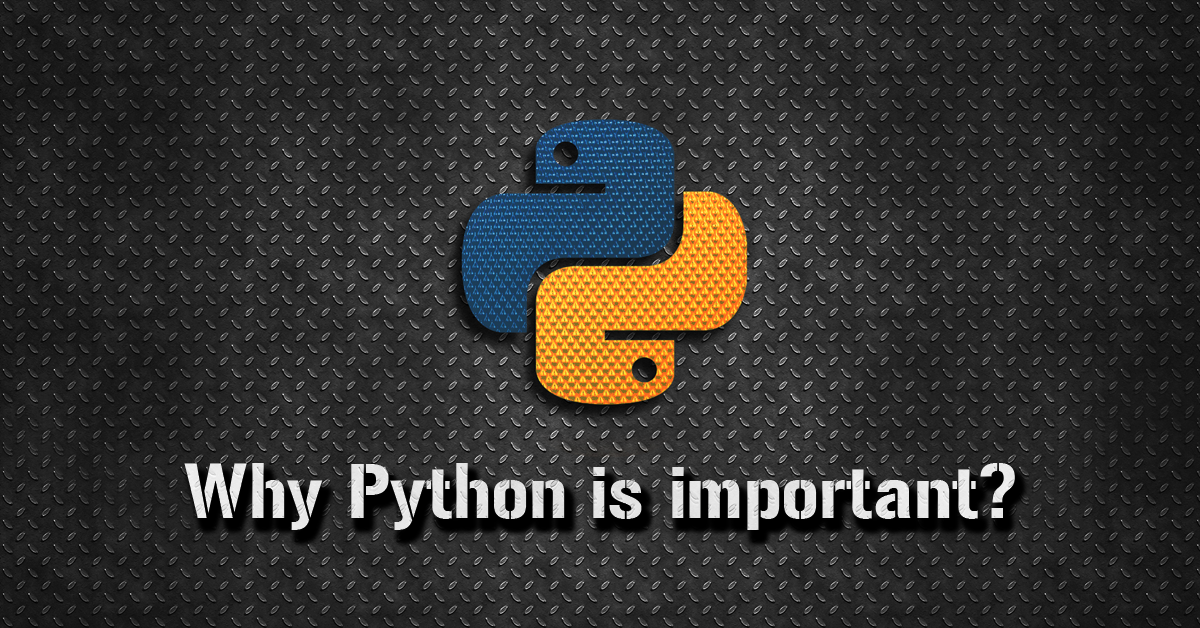Why is learning Python Programming Language important?
What is Python?
Python is a powerful and object-oriented high-level programming language created by Guido van Rossum. It has very simple easy-to-use syntax, which makes it the perfect language for someone trying to learn computer programming for the first time. It works on cross-platform operating systems and can be used across to develop a wide range of applications including those intended for image processing, text processing, web, and enterprise level using scientific, numeric and data from the network.

Applications of Python
1. GUI-Based Desktop Applications
Python is a desirable choice for developing desktop-based application because of its simple syntax, modular architecture, rich text processing tools and the ability to work on multiple operating systems. There are various GUI toolkits like wxPython, PyQt or PyGtk available which help developers create highly functional Graphical User Interface (GUI). The various applications developed using Python includes:
1.1 Image Processing and Graphic Design Applications:
2D imaging software such as Inkscape, GIMP, Paint Shop Pro and Scribus use Python. Also, 3D animation packages, like Blender, 3ds Max, Cinema 4D, Houdini, Lightwave and Maya, also use variable proportions of Python.
2. Scientific and Computational Applications
The higher speeds, productivity and availability of tools, such as Scientific Python and Numeric Python, have made Python becoming an integral part of applications involved in computation and processing of scientific data. 3D modelling software, such as FreeCAD, and finite element method software, such as Abaqus, are coded in Python.
3. Games
There are various modules, libraries and platforms in Python that support the development of games. PySoy is a 3D game engine supporting Python 3, and PyGame provides functionality and a library for game development. Civilization-IV, Disney’s Toontown Online, Vega Strike are few of the games developed in Python.
4. Web Frameworks and Web Applications
A variety of web-frameworks including CherryPy, Django, TurboGears, Bottle and Flask have been created using Python. Standard libraries and modules which these frameworks provide simplify tasks related to content management, interaction with database and interfacing with different internet protocols such as HTTP, SMTP, XML-RPC, FTP and POP. ERP5 – an open source ERP which is used in aerospace, apparel and banking; Plone – a content management system, Odoo – a consolidated suite of business applications; and Google App engine are a few of the popular web applications based on Python.
5. Enterprise and Business Applications
Python is the suitable coding language for customizing larger applications with features that include special libraries, extensibility, scalability and easily readable syntax. Reddit, which was written originally in Common Lips, was rewritten in Python in 2005. Python also contributed in a large part to functionality in YouTube.
6. Operating Systems
Linux distributions often have Python an integral part. For instance, Ubuntu’s Ubiquity Installer, and Fedora’s and Red Hat Enterprise Linux’s Anaconda Installer are written in Python. Gentoo Linux makes use of Python for Portage which is its package management system. Many users write either automation scripts directly against the OpenStack Representational State Transfer (REST) application programming interface (API) or shell scripts that invoke the command-line tools (for example, Keystone or nova). But a better way exists to write OpenStack automation scripts in Python. All of the OpenStack services expose native Python APIs that expose the same feature set as the command-line tools. Unfortunately, not much documentation is available to describe how to use these APIs.
7. Language Development
The design and module architecture of Python has influenced the development of numerous languages. Boo language uses a similar object model, syntax and indentation to Python. The syntax of languages like Apple’s Swift, CoffeeScript, Cobra, and OCaml all share similarity with Python.
8. Cloud and OpenStack
For deploying infrastructure as a Service (IaaS), OpenStack is an increasingly popular Open Source solution. OpenStack has a dashboard web app which is preloaded with it that helps in performing manual tasks, such as launching a single virtual machine (VM) instance, but for automating cloud-based tasks, scripts have to be written that can drive the OpenStack.
Many users write either shell scripts that invoke the command-line tools (for example, keystone or nova) or automation scripts directly against the OpenStack Representational State Transfer (REST) application programming interface (API). OpenStack automation scripts can be written in a better way in Python. These OpenStack services expose native Python APIs that expose the same feature set as the command-line tools. The Python APIs are much easier to work with than command-line tools or the REST API.
9. Big Data Analytics
For fetching live streaming data from the internet the versatile programming languages like Python comes to the rescue where classical programming languages fail.
Every day, as per international statistical reports, WhatsApp gets around 1 million new user registrations and has 700 million active users. There are around 30 billion messages that get sent and 34 billion messages that are received daily (source: statista.com). Twitter statistics reveal that there are 350 million tweets daily and more than 500 million accounts. Data is growing at a rapid rate every moment, and there are predictions that the production and generation of data in 2020 will be 44 times more than 2009 levels (source: http://wikibon.org/blog/big-data-statistics/). This data obtained is unstructured in nature, means that it is indifferent and heterogeneous formats. Such vast volumes are typically known as Big Data. Investigation of intelligent and meaningful patterns from such data in a deep manner is known as Big Data Analytics. A number of researchers and scientists are working in this domain using assorted technologies and tools. There are a number of ways in which live data can be obtained for research and development. One of these is getting data from ‘open data portals’. These portals provide authentic data sets for research and development in multiple domains, which can be downloaded in multiple formats including XML, CSV, JSON and many others.
Python is one of the most outstanding and efficient programming languages that can communicate with the live streaming servers. You can use it to store the fetched data in the database or file system for analysis and predictions.
10. IoT
Though Python started as a scripting language to glue together real code, it’s increasingly used as the main language for many developers. When small devices have enough memory and computational power, the developers turn to Python.
Python is pretty easy to learn and supported by a large, helpful community. The programming syntax for Python is clean and simple, attracting a greater range of programmers. Python is often the first choice for social scientists and biologists, for instance. Python is the language of choice when they need a smart device in the lab.
Python is the language of choice for one of the most popular microcontroller in the market – the Raspberry Pi. Many of the training literature is written in Python, and several schools use the platform to teach computer programming. For relatively simple projects where there are no great computational demands, it is possible to build effective tools from the same boards and libraries that are used in elementary schools.
There are even smaller microcontrollers. A small microcontroller called the MicroPython board and software package is optimized to run Python on a small board which is just a few square inches.
11. Prototyping
Python has the support of a large community with the open source advantage of being free. This has made it the choice for prototype development. The features of agility, extensibility and scalability and ease of refactoring code associated with Python allow faster development from initial prototype.
Python from its origin in 1989 has grown to become part of a plethora of web-based, desktop-based, graphic design, scientific, and computational applications. Python brings about ease of development for enterprises with availability for Windows, Mac OS X and Linux / UNIX. The latest release Python 3.4.3 builds on the existing strengths of the language, with a drastic improvement in Unicode support, among other new features. Hence programming in Python will continue to offer many benefits for organizations, based on their end objectives









